MUSSOLINI’S FASCISTS SPARK RIOTS
Milan, Italy · October 27, 1922
On this date in 1922 in Italy, riots instigated by Benito Mussolini’s National Fascist Party (Partito Nazionale Fascista) erupted in several Italian towns. The Fascists called on the government to resign. The next day four columns of Mussolini’s paramilitary Blackshirts (Camicie nere, or squadristi) began a march from the Northern Italian city of Milan to Rome, Italy’s capital. Consisting of nationalist intellectuals, former army officers, and disgruntled former soldiers, the Blackshirts may have numbered 200,000 by the time of Mussolini’s March on Rome. (In Germany, Adolf Hitler adopted this model for his “Storm Troopers” in the Nazi Party’s Sturmabteilung, who were issued brown shirts and were colloquially known as “Brownshirts.”) Italy’s King Victor Emmanuel III refused the government’s request to declare martial law; instead, he invited Mussolini to form a new government and sent a special train to bring the marchers to the capital. As both prime minister and foreign minister, Mussolini headed a government consisting of Catholics, Social Democrats, Liberals, and four members of his Fascist Party. In the 1924 general election, Mussolini garnered the support of 65 percent of Italian voters, but his impressive support was based on a combination of bluff, violence, and intimidation. In 1926 he dissolved Parliament and established an authoritarian dictatorship that entered into a military pact with Germany and Japan (the Tripartite Pact), which dragged Italy into World War II. Mussolini remained at the helm of state until the long-dormant Grand Council of Fascism deposed him on the night of July 24–25, 1943. This was just days after the start of Operation Husky, the Allies’ amphibious and airborne invasion of Sicily that opened the way to the Allied invasion of the Italian mainland. King Victor Emmanuel, who had allowed Mussolini to “manage” his kingdom for 21 years, ordered the Carabinieri to arrest him on the evening of July 25, 1943. To head his new government, the king appointed Marshal Pietro Badoglio, former Supreme Chief of the Italian General Staff. On September 3, 1943, a week before the Allies’ invasion of the mainland, Badoglio entered into a secret armistice with the Allies, and the next month, on October 13, steered his government into war with Italy’s erstwhile ally, Hitler’s Germany.
[amazon_carousel widget_type=”ASINList” width=”600″ height=”200″ title=”Recommended Reading” market_place=”US” shuffle_products=”False” show_border=”False” asin=”1846035058,1405812532,1906033560,058206595X,1842121235,0340833629,0230606059,1842126067,041573410X,0471591513″ /]
Benito Mussolini and His Fascist Power Grab, Italy in the 1920s
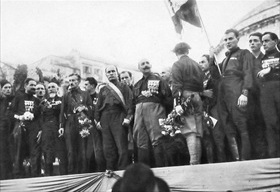 | 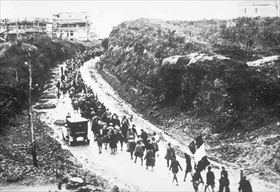 |
Left: Three days before riots broke out in Milan, Mussolini (middle, with sash across chest) addressed a large gathering of Fascist Party Blackshirts, the Voluntary Militia of National Security (MVSN), in Naples, October 24, 1922.
![]()
Right: Fascist marchers, who numbered less than 30,000, approached Rome on October 28, 1922.
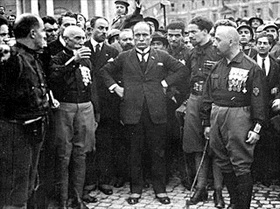 | 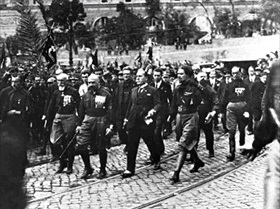 |
Above: A dapper but stern-looking Mussolini during the March on Rome, October 28, 1922, flanked by three of his quadriumviri (principal advisors): Emilio De Bono (on Mussolini’s right), Italo Balbo (Mussolini’s left), and Cesare Maria De Vecchi (with riding crop). De Bono became Minister of Colonies; Balbo, former Air Marshal and Mussolini’s “heir apparent,” became Governor General of Libya in 1933; and De Vecchi became Governor General of Italian Somaliland (1923–1928). Balbo was killed by friendly fire when his plane was shot down over Tobruk, Libya, on June 28, 1940, by Italian anti-aircraft guns.
_1922_280x236.jpg) | 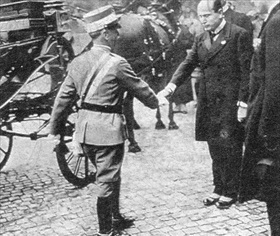 |
Left: Fascists parade in front of the Quirinal Palace, the official residence of King Victor Emmanuel III. The monarchy was abolished in 1946 and the palace became the official residence and workplace for the Presidents of the Italian Republic.
![]()
Right: A photo published in a newspaper shows King Victor Emmanuel officially greeting Mussolini on November 4, 1922, several days following the Fascists’ March on Rome.
Silent Film Showing Mussolini and His Blackshirts of the National Fascist Party Marching on Rome, October 1922
![]()

 History buffs, there is good news! The Daily Chronicles of World War II is now available as an ebook for $4.99 on Amazon.com. Containing a year’s worth of dated entries from this website, the ebook brings the story of this tumultuous era to life in a compelling, authoritative, and succinct manner. Featuring inventive navigation aids, the ebook enables readers to instantly move forward or backward by month and date to different dated entries. Simple and elegant! Click
History buffs, there is good news! The Daily Chronicles of World War II is now available as an ebook for $4.99 on Amazon.com. Containing a year’s worth of dated entries from this website, the ebook brings the story of this tumultuous era to life in a compelling, authoritative, and succinct manner. Featuring inventive navigation aids, the ebook enables readers to instantly move forward or backward by month and date to different dated entries. Simple and elegant! Click 











